Henry V, Count Palatine of the Rhine
Last updatedThis article needs additional citations for verification .(January 2017) |
Henry V | |
|---|---|
| Count Palatine of the Rhine | |
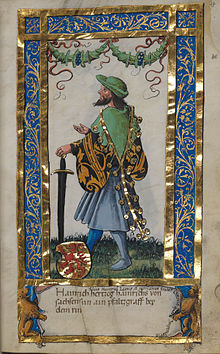 Henry in the Weingarten Stifterbüchlein, c. 1510 | |
| Reign | 1195–1212 |
| Born | c. 1173 |
| Died | 28 April 1227 Braunschweig, Saxony |
| Buried | Brunswick Cathedral |
| Noble family | Guelph |
| Spouse(s) | |
| Issue | |
| Father | Henry the Lion |
| Mother | Matilda of England |
Henry V, the Elder of Brunswick (German : Heinrich der Ältere von Braunschweig; c. 1173 – 28 April 1227), a member of the House of Welf, was Count Palatine of the Rhine from 1195 until 1212.
Contents
Life
Henry was the eldest son of Henry the Lion, Duke of Saxony and Bavaria and Matilda, [1] the eldest daughter of King Henry II of England and Eleanor of Aquitaine.
After his father's deposition by his first-cousin [2] the Hohenstaufen emperor Frederick Barbarossa, he grew up in England. When the family returned to Germany in 1189, young Henry distinguished himself by defending the Welf residence of Braunschweig against the forces of the emperor's son King Henry VI. Peace was established the next year, provided that Henry and his younger brother Lothar (d. 1190) were held in hostage by the king. He had to join the German forces led by Henry VI, by then emperor, on the 1191 campaign to the Kingdom of Sicily and participated in the siege of Naples. Taking advantage of the Emperor falling ill, Henry finally deserted, fled to Marseille, and returned to Germany, where he falsely proclaimed Henry VI's death and tried to underline his own abilities as a possible successor. This partly led to the withdrawal of Henry VI and the captivity of Empress Constance.
Though he was banned, he became heir to the County Palatine of the Rhine through his 1193 marriage to Agnes of Hohenstaufen, a cousin of Emperor Henry VI and daughter of Conrad of Hohenstaufen, Count Palatine of the Rhine, the younger half-brother of the late Emperor Frederick Barbarossa. He and Emperor Henry VI reconciled shortly afterwards, and upon Conrad's death in 1195, Henry was enfeoffed with his County Palatine. A close ally of the emperor, he accompanied him on the conquest of Sicily in 1194/95 and on the Crusade of 1197. [3]
After the sudden death of the emperor in 1197, Henry's younger brother Otto IV became one of two rival kings of the Holy Roman Empire. At first he supported him, but switched sides to Philip of Swabia in 1203. Having divided the Welf allodial lands with his brothers Otto and William of Winchester, Henry then ruled over the northern Saxon territories around Stade and Altencelle and also was confirmed as count palatine by King Philip. When the German throne quarrel ended with Philip's assassination in 1208, Henry again sided with Otto IV. In Imperial service, he tried to ward off the territorial claims by the Rhenish Prince-archbishops of Cologne, Trier and Mainz, though to no avail.
After he inherited further significant properties in Saxony from his brother William in 1213, Henry ceded the Palatinate to his son Henry the Younger and moved north. After his son's early death the next year, he left his Welf properties to his nephew, William's son Otto the Child, who became the first Duke of Brunswick-Lüneburg in 1235. Henry died in 1227 and is entombed in Brunswick Cathedral.
Marriage and children
In 1193, Henry married Agnes of Hohenstaufen (1177–1204), [4] daughter of Count Palatine Conrad. They had the following children:
- Henry VI (1197–1214), married Matilda, daughter of Duke Henry I of Brabant
- Irmengard (1200–1260), married Margrave Herman V of Baden
- Agnes (1201–1267), married Otto II of Wittelsbach, Count palatine of the Rhine from 1214, Duke of Bavaria from 1231.
Around 1209, he married Agnes of Landsberg (d. 1248), daughter of the Wettin margrave Conrad II of Lusatia. [1]
Ancestors
| Ancestors of Henry V, Count Palatine of the Rhine | |||||||||||||||||||||||||||||||||||||||||||||||||||||||||||||||||||||||||||||||||||||||||||||||||||||||||||||||||||||||||||||||||||||||||||||||||||||||||||||||||||||||||||||||||||||||||||||||||||||||||||||||||||||||||||||||||||||||||||||||||||||||||||||||||||||||||||||||||||||||||
|---|---|---|---|---|---|---|---|---|---|---|---|---|---|---|---|---|---|---|---|---|---|---|---|---|---|---|---|---|---|---|---|---|---|---|---|---|---|---|---|---|---|---|---|---|---|---|---|---|---|---|---|---|---|---|---|---|---|---|---|---|---|---|---|---|---|---|---|---|---|---|---|---|---|---|---|---|---|---|---|---|---|---|---|---|---|---|---|---|---|---|---|---|---|---|---|---|---|---|---|---|---|---|---|---|---|---|---|---|---|---|---|---|---|---|---|---|---|---|---|---|---|---|---|---|---|---|---|---|---|---|---|---|---|---|---|---|---|---|---|---|---|---|---|---|---|---|---|---|---|---|---|---|---|---|---|---|---|---|---|---|---|---|---|---|---|---|---|---|---|---|---|---|---|---|---|---|---|---|---|---|---|---|---|---|---|---|---|---|---|---|---|---|---|---|---|---|---|---|---|---|---|---|---|---|---|---|---|---|---|---|---|---|---|---|---|---|---|---|---|---|---|---|---|---|---|---|---|---|---|---|---|---|---|---|---|---|---|---|---|---|---|---|---|---|---|---|---|---|---|---|---|---|---|---|---|---|---|---|---|---|---|---|---|---|---|---|---|---|---|---|---|---|---|---|---|---|---|---|---|---|---|
| |||||||||||||||||||||||||||||||||||||||||||||||||||||||||||||||||||||||||||||||||||||||||||||||||||||||||||||||||||||||||||||||||||||||||||||||||||||||||||||||||||||||||||||||||||||||||||||||||||||||||||||||||||||||||||||||||||||||||||||||||||||||||||||||||||||||||||||||||||||||||
Related Research Articles

The Hohenstaufen dynasty, also known as the Staufer, was a noble family of unclear origin that rose to rule the Duchy of Swabia from 1079, and to royal rule in the Holy Roman Empire during the Middle Ages from 1138 until 1254. The dynasty's most prominent rulers – Frederick I (1155), Henry VI (1191) and Frederick II (1220) – ascended the imperial throne and also reigned over Italy and Burgundy. The non-contemporary name of 'Hohenstaufen' is derived from the family's Hohenstaufen Castle on Hohenstaufen mountain at the northern fringes of the Swabian Jura, near the town of Göppingen. Under Hohenstaufen rule, the Holy Roman Empire reached its greatest territorial extent from 1155 to 1268.

The Electoral Palatinate or the Palatinate, officially the Electorate of the Palatinate, was a state that was part of the Holy Roman Empire. The electorate had its origins under the rulership of the Counts Palatine of Lotharingia in 915; it was then restructured under the Counts Palatine of the Rhine in 1085. From 1214 until the Electoral Palatinate was merged into the Kingdom of Bavaria in 1805, the House of Wittelsbach provided the Counts Palatine or Electors. These counts palatine of the Rhine would serve as prince-electors from "time immemorial", and were noted as such in a papal letter of 1261; they were confirmed as electors by the Golden Bull of 1356.

The House of Welf is a European dynasty that has included many German and British monarchs from the 11th to 20th century and Emperor Ivan VI of Russia in the 18th century. The originally Franconian family from the Meuse-Moselle area was closely related to the imperial family of the Carolingians.

Frederick II, called the One-Eyed, was Duke of Swabia from 1105 until his death, the second from the Hohenstaufen dynasty. His younger brother Conrad was elected King of the Romans in 1138.
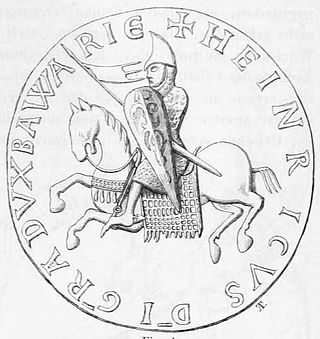
Henry II, called Jasomirgott, a member of the House of Babenberg, was Count Palatine of the Rhine from 1140 to 1141, Duke of Bavaria and Margrave of Austria from 1141 to 1156, and the first Duke of Austria from 1156 until his death.
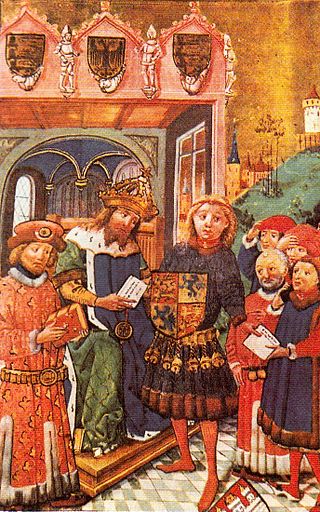
Otto I of Brunswick-Lüneburg, a member of the House of Welf, was the first duke of Brunswick-Lüneburg from 1235 until his death. He is called Otto the Child to distinguish him from his uncle, Emperor Otto IV.
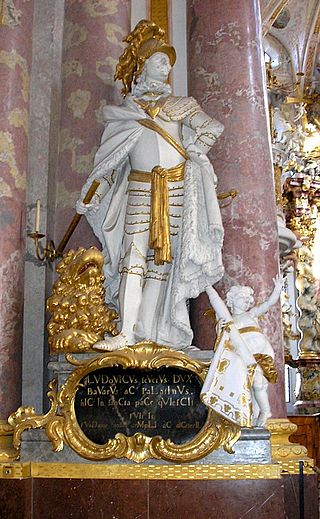
Louis the Strict was Duke of Upper Bavaria and Count Palatine of the Rhine from 1253. He is known as Louis II or Louis VI following an alternative numbering. Born in Heidelberg, he was a son of Otto II Wittelsbach, Duke of Bavaria and Agnes of the Palatinate.
Louis I, called the Kelheimer or of Kelheim, since he was born and died at Kelheim, was the Duke of Bavaria from 1183 and Count Palatine of the Rhine from 1214. He was the only surviving son of Otto I, Duke of Bavaria by his wife Agnes of Loon. He married Ludmilla of Bohemia, a daughter of Duke Frederick of Bohemia.
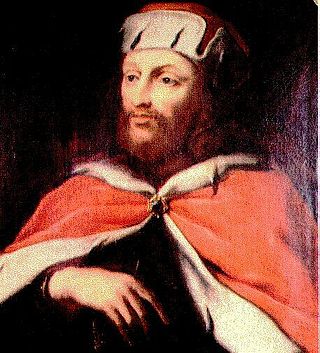
Otto I, called the Redhead, was Duke of Bavaria from 1180 until his death. He was also called Otto VI as Count Palatine of Bavaria from 1156 to 1180. He was the first Bavarian ruler from the House of Wittelsbach, a dynasty which reigned until the abdication of King Ludwig III of Bavaria in the German Revolution of 1918.
Conrad of Hohenstaufen was the first hereditary Count Palatine of the Rhine.

Welf VI was the margrave of Tuscany (1152–1162) and duke of Spoleto (1152–1162), the third son of Henry IX, Duke of Bavaria, and a member of the illustrious family of the Welf.
Otto I was Count of Burgundy from 1190 to his death and briefly Count of Luxembourg from 1196 to 1197. He was the fourth son of Frederick I, Holy Roman Emperor, by his second wife Beatrice I, Countess of Burgundy, daughter of Count Renaud III.

Berthold IV, a member of the House of Andechs, was Margrave of Istria and Carniola. By about 1180/82 he assumed the title of Duke of Merania, referring to the Adriatic seacoast of Kvarner which his ancestors had conquered in the 1060s and annexed to Istria and Carniola.

Elisabeth of Bavaria, a member of the House of Wittelsbach, was Queen of Germany and Jerusalem from 1246 to 1254 by her marriage to King Conrad IV of Germany.

Gertrude of Sulzbach was German queen from 1138 until her death as the second wife of the Hohenstaufen king Conrad III.

Agnes of the Palatinate (1201–1267) was a daughter of Henry V, Count Palatine of the Rhine, of the House of Welf, by his first wife Agnes of Hohenstaufen, daughter and heiress of Conrad of Hohenstaufen, Count Palatine of the Rhine. She married Otto II Wittelsbach, Duke of Bavaria.
Henry VI "the Younger" of Brunswick, of the House of Welf, was Count Palatine of the Rhine from 1212 to 1214.

Henry VI, a member of the Hohenstaufen dynasty, was King of Germany from 1169 and Holy Roman Emperor from 1191 until his death. From 1194 he was also King of Sicily.
Agnes of Hohenstaufen was the daughter and heiress of the Hohenstaufen count palatine Conrad of the Rhine. She was Countess of the Palatinate herself from 1195 until her death, as the wife of the Welf count palatine Henry V.
References
- 1 2 Lyon 2013, p. 243.
- ↑ Barbarossa was the son of Judith of Bavaria, sister of Henry X, Duke of Bavaria, father of Henry the Lion
- ↑ Nicholson 2001, p. 129.
- ↑ Schutz 2010, p. 239.
Sources
- Lyon, Jonathan R. (2013). Princely Brothers and Sisters: The Sibling Bond in German Politics, 1100-1250. Cornell University Press.